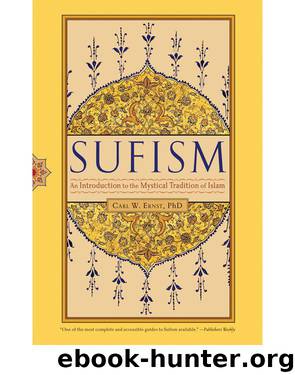Sufism by Carl W. Ernst

Author:Carl W. Ernst
Language: eng
Format: epub
Publisher: Shambhala
FIGURE 10. Initiatic Genealogy or “Tree” (shajara) of the Indian Naqshbandi Order.
It is necessary for the disciple, after receiving from his own master the names of the [preceding] masters, that he memorize them up to the revered exemplar of prophecy (blessings and peace be upon him). This is one of the requirements of the seeker on this path. For the one practicing spiritual exercises it is necessary to bring the master to mind during dhikr and meditation. If he is not successfully present [in the meditation,] at first he thinks of the master. If he still does not attain presence, [he thinks of] the master of the master. If he still does not attain presence, [he thinks of] the master of the master of the master. If he still does not attain presence, [he thinks of] the master of the master of the master of the master, all the way up to the Prophet (God bless him and his family and give them peace). While recalling each of these saints to whom the revered [Prophet] has given the hand [of initiation,] he begins the dhikr with that one [that is, the Prophet], and visualizes him in the form of the master. Then he asks for assistance and practices the dhikr.15
Knowing the names of previous masters has a virtue comparable to the recitation of the names of God; the spiritual qualities of those saints will communicate themselves to those who write or recite their names. Writing out a genealogical tree is said to have become necessary in later times, when the number of intermediaries multiplied. This distance in time from the Prophet is not necessarily a diminution of spiritual power. Since the chains are attested by trustworthy masters, those with more links have greater merit—just as additional lamps contribute more light. Authorities differ on the question of where to start writing the tree. Some prefer to begin with the Prophet, but others start with their own names and ascend up through the masters, to fulfill the manners of respect to each in order.
While the genealogical tree is probably the most elemental representation of a Sufi order, there are much more detailed constructions of the historical relations of masters and disciples. Some tree documents contain brief biographical notes, and they represent not only the principal masters but also the circles of minor disciples that surrounded them. While a simple tree document can be contained on one page, there are shrines in India where genealogical scrolls hundreds of feet long are preserved. The precise meaning of these more complicated diagrams is elusive in the absence of oral commentary. Eminent masters of other orders are juxtaposed alongside the chief representatives of a chain in a relationship that is suggestive but enigmatic. It is clear that each document represents a principal line of transmission that eventually reaches the disciple whose name is inscribed at the bottom.
The apparently simple statement of authority contained in these graphic representations conceals significant differences of opinion about legitimate succession. As
Download
This site does not store any files on its server. We only index and link to content provided by other sites. Please contact the content providers to delete copyright contents if any and email us, we'll remove relevant links or contents immediately.
The History of Jihad: From Muhammad to ISIS by Spencer Robert(2509)
Nine Parts of Desire by Geraldine Brooks(2283)
The Turkish Psychedelic Explosion by Daniel Spicer(2247)
The First Muslim The Story of Muhammad by Lesley Hazleton(2159)
The Essential Rumi by Coleman Barks(1932)
1453 by Roger Crowley(1881)
The Last Mughal by William Dalrymple(1796)
Trickster Travels: A Sixteenth-Century Muslim Between Worlds by Davis Natalie Zemon(1785)
Muhammad: His Life Based on the Earliest Sources by Martin Lings(1569)
God by Aslan Reza(1564)
by Christianity & Islam(1564)
A Concise History of Sunnis and Shi'is by John McHugo(1518)
Magic and Divination in Early Islam by Emilie Savage-Smith;(1461)
No God But God by Reza Aslan(1438)
The Flight of the Intellectuals by Berman Paul(1401)
Art of Betrayal by Gordon Corera(1367)
Nothing to Envy by Barbara Demick(1329)
What the Qur'an Meant by Garry Wills(1326)
Getting Jesus Right: How Muslims Get Jesus and Islam Wrong by James A Beverley & Craig A Evans(1279)
